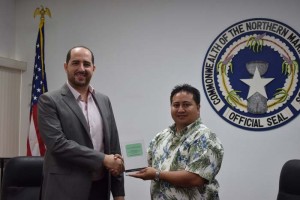Spanish historian: Collaboration will open opportunities

Spanish historian Dr. Carlos Madrid, PhD, left, presents a book about the genealogy of local families to Gov. Ralph DLG Torres. (Jon Perez)
The CNMI government could benefit from having closer ties with private foundations in Spain. These could result in the Commonwealth receiving grants and other materials that would reconnect it to its Spanish past.
The Marianas, with Guam, was a stopover of the Manila-Acapulco galleon trade route, linking commerce between East and Southeast Asia and Europe.
Carlos Madrid, Ph.D., who used to do lectures on Saipan, met with Gov. Ralph DLG Torres last Tuesday to ask the CNMI’s permission to borrow several artifacts from the Spanish galleon Nuestra Señora de la Concepción that ran aground near Agingan Point on Saipan.
Philippine Consul General to Guam and CNMI Marciano R. de Borja, Philippine consul Mark Francis C. Hamoy, Philippine honorary consul to the CNMI Eli Arago, and his CNMI volunteers Annamae Adaza and Mario Mayuga were also present at the meeting.
The Concepcion collection is currently exhibited at the Saipan Museum of History and Culture. Madrid hopes to borrow some pieces that will be shown at the Museo del Galleon in Manila, Philippines this year. The exhibit will have its initial opening on Aug. 8 at the sprawling Mall of Asia complex.
Madrid said he could help arrange a possible collaboration, where the CNMI could receive funding from museums and private historical organizations in Spain.
“It could open a line of communication between the CNMI and Spain. …Particularly with the collection we’re trying to borrow, it is a start. They could receive grants, publication, and we could consider bringing some of our collection here as a way to also promote tourism.”
He said the CNMI could benefit once the galleon trade route gets on the list of the United Nations Educational, Scientific, and Cultural Organization’s world heritage sites. Spain, the Philippines, and Mexico are supporting its inclusion in the UNESCO list since it was one of the historic part of the world.
“That could be mutually beneficial for the CNMI. It would be great for the CNMI to be part of it since it has one of the greatest collection and pieces in Micronesia. And we want to establish institutional and professional relations with all museums in the area.”
The [Saipan] museum probably is the best in Micronesia and the people here should take pride of that.
“Another one is the Palau National Museum, but the one here is a gem. What we’re interested is establishing an agreement to borrow part of the collection and exhibit it at the Museo de Galleon, with proper accreditation, then return it after that.”
Open to idea
Torres said he would meet with Department of Community and Cultural Affairs Secretary Robert Hunter on how the CNMI could help with the project.
“We’re hoping to have a good working relationship with Dr. Madrid and the Philippine museum.”
“We’re interested on how we could partner with them. I’m going to meet with Secretary Hunter and we’ll see how this project could push through. The artifacts and other pieces are for sharing and it showcases our rich history.”
Torres added the partnership would be a little incentive that the CNMI government could look into. Some of the artifacts are also listed and under the possession of Bank of Guam.
He said the project is also timely as they already have a sponsor that is interested to revamp, re-organize, and rebuild the Saipan museum. “This is something that’s moving forward and making sure that we have a new, improved museum that would become part of our tourism.”
Museo de Galleon
De Borja said the Museo de Galleon, where an exact replica of a Spanish galleon would also be displayed, is a project of the Museo de Galleon Inc. in partnership with the SM Foundation, and various organizations in Spain.
“Dr. Madrid is here for a cultural project that would promote the common Spanish past of the Philippines and the CNMI. We know that the Saipan museum has a collection of artifacts from the Concepción.”
“We want to work something out and have an arrangement with the CNMI in borrowing some of the collections so we could exhibit it in the Philippines. We’re going to look at the inventory, then take care of the insurance and transporting the artifacts.”
He added the pieces would make the CNMI known internationally since the museum’s opening coincides with the 50th founding anniversary of the Association of Southeast Asian Nations.
De Borja said the expect the new musum to have 25,000 visitors a month. “And there’s a fee in the museum and part of the proceeds will be given to the [Saipan] museum. So, it’s a win-win situation for all.”
The Museo de Galleon would give visitors a closer look of the 250-year history of the major roles played by the Philippines and Mexico in the global commercial trade during the Spanish era.



























